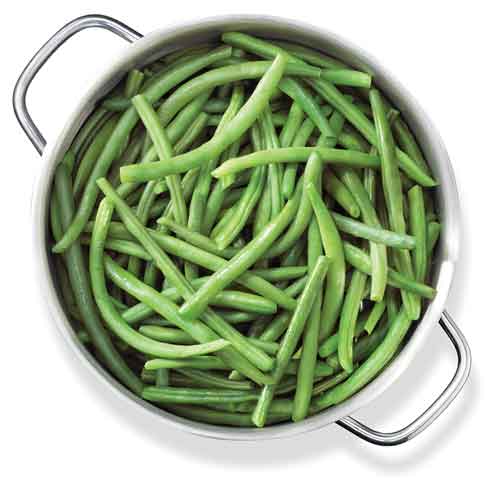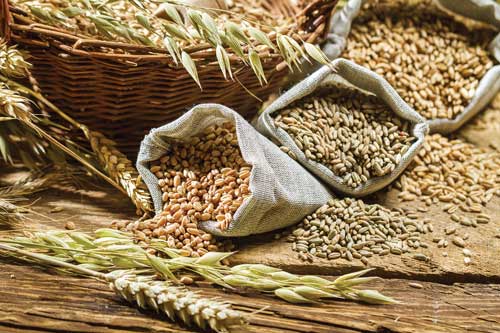Exploring vegetable cooking methods; What drives purchase decisions
NEWS
 Impact of cooking method on vegetables
Impact of cooking method on vegetablesA recent Journal of Food Science study examined the effects of three cooking methods on the physicochemical and structural characteristics of cut and cooked vegetables. In the study, purple-flesh potatoes, green beans, and carrots were cooked using three methods: traditional boiling (100°C), cook-vide (80°C and 90°C), and sous-vide (80°C and 90°C). These latter two methods employ lower temperatures and less oxygen. No matter the method, the firmness and cooking time of the potatoes remained the same, but the green beans and carrots required a longer cooking time using sous-vide to achieve the same firmness level.
Traditional cooking reduced the anthocyanin level in the potatoes and the ascorbic acid in the green beans, while sous-vide preserved the organelles in the carrots, limiting the extraction of beta-carotene. The researchers recommend sous-vide cooking for potatoes in order to retain their anthocyanins and either sous-vide or cook-vide to preserve the ascorbic acid in green beans. Traditional boiling, meanwhile, increases the bioavailability of beta-carotene in carrots.
Maria Consuelo Iborra-Bernad, one of the study’s authors, suggests that food companies might use these results to adapt how they prepare vegetables to provide versions with the best nutritional profile possible. “Moreover,” she notes, “they could provide supermarkets with a range of vegetables cooked their optimal way to be sold in individual packets. Thus, the consumer could choose and mix different vegetables.”
Driving consumer purchase decisions
Technology, transparency, and the desire for instant gratification and personalization are driving consumer purchasing decisions in a variety of ways, according to Lynn Stachura, senior vice-president of insights at Dairy Management Inc., who spoke during the U.S. Dairy Innovation Conference presented by the U.S. Dairy Export Council in cooperation with the United Dairymen of Idaho.
Technology has allowed consumers to become more and more informed about the food they eat, and mobile devices mean that they are constantly connected. According to research Stachura presented, two-thirds of Americans say that it is important to always be reachable. “They want it all, they want it now, and they want it quickly,” she noted.
In this spirit of connectedness, consumers are drawn to companies they feel are trying to form a personal connection with them; 87% of global consumers are looking for meaningful relationships with brands, but only 17% of consumers believe companies are delivering. Consumers also want companies to personalize product options to help them navigate the purchase maze; 51% of Americans feel that having fewer choices helps them make a purchase decision.
In addition, consumers expect the companies they do connect with to be environmentally responsible, transparent, and minimalist when it comes to ingredient lists. But on this last point, Stachura believes companies should find ways to explain why they use the ingredients they do and show what function they play in the final product. She advises them to consider focusing on being “not clean but clear.”
Edible coatings preserve strawberries, pomelos
Two Journal of Food Science studies found that applying edible coatings to strawberries or pomelos helped preserve the produce’s freshness.
The first study, Edible Active Coatings Based on Pectin, Pullulan, and Chitosan Increase Quality and Shelf Life of Strawberries (Fragaria ananassa)”, applied edible active coatings (EACs) based on pectin, pullulan, and chitosan incorporated with sodium benzoate and potassium sorbate. Applying EACs reduced microbial growth, with the chitosan-EAC strawberries presenting the best results in this area, though all three EACs improved sensory qualities and decreased decay rate.
Edible coatings have not been used often with cut citrus, according to the authors of the second study, “Synergistic Effect of Sodium Chlorite and Edible Coating on Quality Maintenance of Minimally Processed Citrus grandis Under Passive and Active MAP”. In this study, researchers applied three treatments to cut pomelos stored under both passive and active modified atmosphere packaging (MAP): an edible coating made from N,O-carboxymethyl chitosan (NOCC), sodium chlorite (SC), and NOCC with SC. They found that freshness was maintained best in the pomelos treated with both NOCC and SC under active MAP and lost weight and decayed more quickly when only NOCC was applied.
--- PAGE BREAK ---
 More Americans eating whole grains
More Americans eating whole grains
Sixty-three percent of Americans say that at least half the grains they consume are whole ones, and a majority of Americans are eating more whole grains than they did five years ago, according to the Whole Grains Consumer Insights Survey from Oldways Whole Grains Council, a nonprofit based in Boston.
“For years, most people came nowhere close to whole grain recommendations, so it is encouraging to see that many are now benefiting from switching more of the grains they eat to whole grains,” says Cynthia Harriman, director of food and nutrition strategies for Oldways Whole Grains Council.
According to the survey, 31% of respondents say they nearly always choose whole grains, compared with the 4% who said so five years ago. Another 32% say they choose whole grains about half the time. Breakfast is the most popular eating occasion for whole grains, with 37% consumed then, followed by 27% at dinner, 22% at lunch, and 14% at snack time.
Eighty-six percent of respondents say they eat whole grains for the health benefits, with just 40% doing so because they enjoy the taste. In addition, cost and availability were cited as barriers to consuming more whole grains. Variety is also limited: while nine in 10 respondents have heard of and/or eaten whole wheat, oats, and brown rice, fewer than one in five have heard of spelt, farro, amaranth, Kamut, or teff. “The next step is tempting Americans to expand their whole grain palates beyond bread, cereal, and brown rice to delicious grains like spelt, farro, amaranth, and teff,” says Harriman.
Reducing foodborne illness outbreaks from spinach
A change in the way spinach leaves are washed could help prevent the spread of bacteria, reducing the number of foodborne illnesses associated with consuming leafy greens, according to research presented at the National Meeting & Exposition of the American Chemical Society.
“Our experiments were telling us that commercial bleach rinses should be much more effective than they are,” explains Sharon Walker from the University of California, Riverside. “But then we studied the leaf itself in more detail.”
Walker and her colleague, Nichola Kinsinger, found that the bumps and ridges in spinach leaves meant that some 15% of the surface area may “see” a bleach concentration 1,000 times less than that of the rinse solution—and result in 90% bacterial survival, presenting a high risk for cross contamination. To reduce that risk, the scientists introduced a low-cost titanium dioxide (TiO2) photocatalyst that can be added to the rinse; when TiO2 is exposed to light, it produces an oxidant that kills bacteria.
News Bites
• Activ International relocated its manufacturing and R&D plant to Somerset, N.J.
• Ardent Mills will acquire Mondelēz Canada’s flour mill located in Mississauga, Canada.
• Bala Balasubramaniam of The Ohio State University gave a webinar for the USDA NIFA called “Shelf Life Extension of Foods with Fresh-Like Quality Attributes by High Pressure.”
• Barry Callebaut launched the Cocoa Horizons Foundation, an independent nonprofit organization that aims to improve the livelihoods of cocoa farmers and their communities.
• Cargill will invest $100 million in order to expand its soybean crush operation in Borg El Arab, Egypt.
• CHS acquired the Northstar Agri Industries canola processing and refining plant near Hallock, Minn., from PICO Northstar.
• The Dannon Co. announced its fourth annual Yogurt & Probiotics Fellowship Program, which offers a $25,000 scholarship to a current or incoming graduate student. Applications are due Nov. 13. Visit bit.ly/1OtjJ52.
• Flowers Foods entered into a definitive agreement to acquire Alpine Valley Bread, a family-owned producer of certified organic and all-natural breads.
• Frutarom acquired Vitiva, which supplies natural pharmaceutical ingredients. It also purchased 79% of the shares of Nutrafur, which specializes in the R&D, manufacture, and sales and marketing of plant extracts bearing antioxidant properties or scientifically proven health qualities.
• General Mills reached a definitive agreement to sell its Green Giant and Le Sueur vegetable businesses to B&G Foods. It also set a goal of reducing its greenhouse gas emissions by 28% over the next 10 years across its value chain.
• Heartland Food Products Group entered into a definitive agreement to acquire the retail Splenda brand from Johnson & Johnson Consumer.
• Ingredion will consolidate its manufacturing network in Brazil.
• Kellogg Co. will remove all artificial colors and flavors from its cereals by 2018.
• McCormick announced that 80% of its U.S. gourmet herbs and spices will be organic and non-GM by 2016, and more than 70% of all McCormick-branded herbs, spices, and extracts in the United States will be labeled non-GM.
• Mondelēz International opened a new $30 million state-of-the-art chocolate production line in Skarbimierz, Poland.
• Nestlé announced that it will use only sustainably sourced cocoa to manufacture KitKat products beginning in the first quarter of 2016.
• Perdue purchased Natural Food Holdings, including the well-known Niman Ranch brand, from LNK Partners, a private equity firm.
• The Purdue Center for Global Food Security seeks applications for U.S. Borlaug Fellows in global food security. Applications are due Nov. 9. Visit bit.ly/1LwalZ9.
• SunOpta acquired frozen and organic fruits supplier Sunrise Growers.
• The U.S. Dept. of Agriculture announced the first national goal to reduce food waste—50% by 2030.
• Alice Wilkinson, vice-president of nutritional innovation at Watson, spoke at SupplySide West in Las Vegas.
• Yael Vodovotz of The Ohio State University was the featured expert in a TIME article titled “Should I Eat Pretzels?”
 Melanie Zanoza Bartelme,
Melanie Zanoza Bartelme,
Associate Editor
[email protected]
